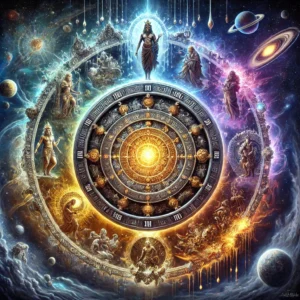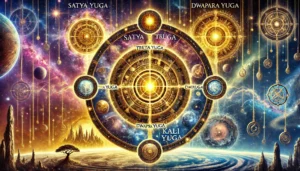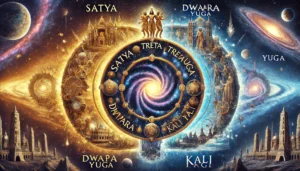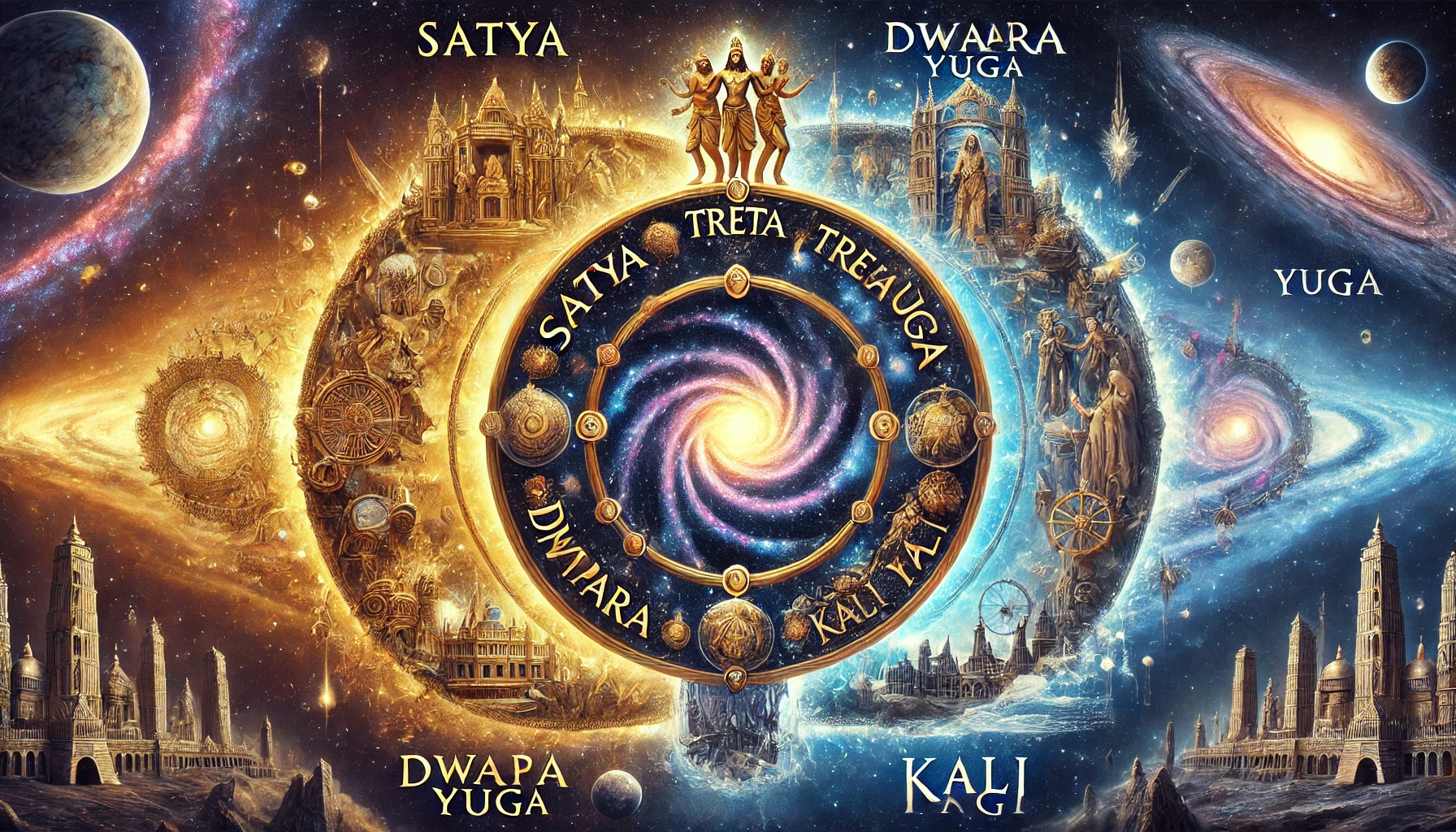
Yugas and Cosmic Time Cycles
Yugas and Cosmic Time Cycles – Are We Stuck in a Time Loop?
The concept of time in Sanatan Dharma is vast, intricate, and cyclical. Unlike the linear perception of time in modern science, Hindu cosmology envisions an eternal cosmic order where time moves in repeating cycles called Yugas, forming a never-ending rhythm of creation, preservation, and destruction.
This raises a profound question: Are we trapped in an endless loop of repeating ages, or is there a deeper spiritual purpose to these cosmic time cycles? Does humanity have the power to break free, or are we merely passengers in this grand cosmic design?
Understanding the Yugas – The Four Cosmic Ages
The Hindu scriptures describe four Yugas, or cosmic ages, that cycle in a predictable yet profound pattern. Each Yuga represents a different stage in the moral and spiritual evolution (or degradation) of humanity.
- Satya Yuga (Golden Age) – The Age of Truth and Purity
- Duration: 1,728,000 years
- Dharma: 100% (Perfect righteousness)
- Characteristics:
- Humanity exists in perfect harmony with nature and divine laws.
- People live long lives filled with wisdom, truth, and peace.
- There is no need for organized religion because everyone naturally follows Dharma.
This age is often compared to paradise on Earth, a time of purity and enlightenment where divine beings interact freely with mortals.
- Treta Yuga (Silver Age) – The Beginning of Decline
- Duration: 1,296,000 years
- Dharma: 75%
- Characteristics:
- The first signs of human imperfection appear, and desires begin to influence actions.
- The balance of nature is slightly disturbed, and suffering starts to emerge.
- Rulers must enforce Dharma, as people begin to forget their divine nature.
- This is the Yuga in which Lord Rama incarnates to restore righteousness.
Treta Yuga is still a time of great virtue, but the gradual decay of truth signals the inevitable decline to come.
- Dvapara Yuga (Bronze Age) – The Rise of Materialism
- Duration: 864,000 years
- Dharma: 50%
- Characteristics:
- Spirituality is no longer instinctive; rituals and temples become necessary.
- Society becomes more divided, and rulers must establish laws to maintain order.
- People experience suffering, conflict, and the consequences of their actions more directly.
- Lord Krishna incarnates in this Yuga, guiding humanity through the Bhagavad Gita.
This is the Yuga where human desires, greed, and conflicts become more prominent. Dharma still exists, but it requires conscious effort to sustain.
- Kali Yuga (Iron Age) – The Age of Darkness and Ignorance
- Duration: 432,000 years
- Dharma: 25% (Minimal righteousness)
- Characteristics:
- Materialism, corruption, and spiritual decline dominate society.
- Wars, deception, and selfishness become common.
- People live shorter lives, disconnected from higher truths.
- The influence of negative energies increases, leading to suffering.
Hindu scriptures, including the Vishnu Purana and Srimad Bhagavatam, describe Kali Yuga as a period of extreme degeneration, where greed, dishonesty, and immorality flourish. However, it is also the Yuga where spiritual liberation is the easiest through Bhakti (devotion), as even a small effort can yield great rewards.

Yugas and Cosmic Time Cycles
Table of Contents
The Cosmic Time Loop – Are We Doomed to Repeat?
Hindu cosmology suggests that these Yugas repeat endlessly in a grand cycle called a Maha Yuga (4.32 million years). A thousand such Maha Yugas form a Kalpa (4.32 billion years), which is equivalent to a single day of Brahma, the Creator. When Brahma’s day ends, the universe dissolves into a cosmic night, only to be reborn again.
This raises a fascinating question—are we trapped in a cosmic time loop? Are we reliving the same events, civilizations, and mistakes over and over again?
- The Eternal Recurrence – Is History Repeating Itself?
The Yugas imply a cyclic pattern where history repeats itself in different forms. Many ancient civilizations, such as Atlantis, are believed to have fallen due to excessive pride and misuse of technology—much like our modern world. The rise and fall of great empires throughout history mirror the transitions between Yugas.
Could it be that we are not advancing but merely moving in circles, reliving variations of the same struggles?
- The Expanding and Contracting Universe – A Scientific Parallel
Modern astrophysics suggests that the universe may undergo cyclic expansion and contraction, similar to the Hindu concept of Pralaya (cosmic dissolution) and rebirth. The Big Bang theory proposes that the universe had a beginning, but some scientists speculate it might eventually collapse and be reborn in an endless cycle.
This idea closely mirrors Hindu cosmology, where the universe is created and dissolved periodically. It suggests that the Yugas are not just a myth but a reflection of universal laws of time and space.
- Divine Interventions – Breaking the Cycle
In every Yuga, divine incarnations (avatars) descend to restore Dharma and guide humanity. Lord Vishnu incarnated as:
- Matsya, Kurma, and Varaha in Satya Yuga
- Rama in Treta Yuga
- Krishna in Dvapara Yuga
- Kalki (yet to come) in Kali Yuga
The arrival of Kalki Avatar at the end of Kali Yuga will mark the destruction of evil and the transition back to Satya Yuga, resetting the cycle.
Is There an Escape from the Cycle?
While the cosmic cycle appears eternal, Hindu philosophy provides a path to liberation:
- Moksha – The Ultimate Escape
- Moksha, or liberation, allows the soul to break free from the cycle of birth and rebirth.
- This can be achieved through Jnana (knowledge), Bhakti (devotion), Karma (righteous action), and Dhyana (meditation).
2. The Role of Free Will
- Though Yugas repeat, individuals are not bound by them. One’s actions (Karma) determine their fate, and with effort, one can transcend worldly cycles.
3. Are We in a Loop or a Spiral?
- Some believe time is not a perfect circle but a spiral—while cycles repeat, they also bring new opportunities for growth.
- Spiritual evolution continues even as civilizations rise and fall.

Yugas and Cosmic Time Cycles
Conclusion – Embracing the Cosmic Rhythm
The Yugas remind us that history moves in cycles, but each cycle offers a chance for transformation. We may be experiencing a time loop, but we are not prisoners of it. Through wisdom, self-awareness, and spiritual discipline, we can rise beyond the limitations of the material world.
Are we stuck, or are we evolving? The answer depends on how we choose to navigate the cosmic cycle. Will you repeat the past, or will you break free?
What are your thoughts? Share your views in the comments below!
FAQs on “Yugas and Cosmic Time Cycles: Are We Trapped in an Eternal Loop of Time?”
- What are Yugas in Hinduism?
Yugas are large cosmic time cycles in Hindu cosmology that describe different ages of human civilization. There are four Yugas: Satya Yuga (Golden Age), Treta Yuga, Dvapara Yuga, and Kali Yuga (Dark Age). Each Yuga has different characteristics, moral values, and spiritual consciousness levels.
- How long does each Yuga last?
According to Hindu scriptures, the Yugas follow a 4:3:2:1 ratio in duration:
- Satya Yuga – 1,728,000 years
- Treta Yuga – 1,296,000 years
- Dvapara Yuga – 864,000 years
- Kali Yuga – 432,000 years
A full cycle of these four Yugas is called a Maha Yuga (4.32 million years).
- Are we currently in Kali Yuga?
Yes, according to Hindu traditions, we are currently in Kali Yuga, which is believed to have started in 3102 BCE after the departure of Lord Krishna. Kali Yuga is considered an era of decline in morality, spiritual wisdom, and truth.
- Do Yugas repeat in a cycle?
Yes, the Yugas form a continuous cycle. After Kali Yuga ends, a new Satya Yuga (Golden Age) begins again. This cycle repeats indefinitely, similar to the concept of a cosmic time loop.
- Is time truly cyclical, or is it linear?
Hindu cosmology primarily sees time as cyclical, unlike the Western concept of linear time (beginning and end). The Yuga cycles repeat endlessly, similar to the cosmic cycles of creation and destruction described in texts like the Bhagavad Gita and Vishnu Purana.
- Does science support the concept of Yugas and time cycles?
While modern science does not explicitly support Yugas, the concept of cyclical time is present in many cultures and theories, such as astronomical cycles, Mayan calendar cycles, and theories of cyclic cosmology proposed by modern physicists.
- Can we escape the time cycle of Yugas?
Hindu philosophy suggests that individuals can transcend the cycle of time and rebirth (Samsara) through spiritual awakening, self-realization, and devotion (Bhakti, Jnana, and Karma Yoga). Enlightened beings are said to be free from the cycles of time and karma.
- When will Kali Yuga end?
Kali Yuga is said to last 432,000 years, and we are only around 5,000 years into it. Some interpretations suggest that as time progresses, spiritual awakening will eventually lead to the transition into the next Satya Yuga.
- Are there any signs that Kali Yuga is nearing its end?
According to Hindu scriptures, Kali Yuga will end with extreme moral decay, widespread suffering, and natural disasters. However, it is also said that Lord Kalki, the 10th avatar of Vishnu, will appear to restore righteousness and usher in the next Satya Yuga.
- What is the significance of understanding Yugas in today’s world?
Understanding Yugas helps us recognize historical patterns, human behavior, and spiritual evolution. It also encourages us to live ethically, seek higher consciousness, and prepare for the eventual transition into a new era of spiritual enlightenment.
Summary
Time, as understood in Hindu cosmology, is not linear but cyclical, governed by the four Yugas—Satya, Treta, Dvapara, and Kali. These ages follow a continuous cycle of rise and decline, mirroring the rhythms of creation, preservation, and destruction. Each Yuga marks a shift in human consciousness, morality, and spiritual evolution, gradually descending from the golden age of Satya Yuga to the chaos and materialism of Kali Yuga before the cycle resets.
This cosmic framework raises a profound question: Is history truly progressing, or are we merely reliving the same events in an endless loop? The concept of eternal recurrence appears in various traditions, from Hindu and Buddhist philosophies to Western thinkers like Nietzsche. Some even draw parallels with modern scientific theories, such as cyclic cosmology, which suggests that the universe undergoes infinite cycles of expansion and contraction.
Exploring the Yuga cycles not only offers insight into ancient wisdom but also challenges our perception of time and destiny. Are we bound to repeat the past, or do we have the power to break free from this cosmic loop? Understanding the deeper meaning behind these cycles might hold the key to transcending them.
Unlock the Ancient Wisdom of Sanatan Dharma – Join Us on YouTube!
👉 Subscribe now to Prachin Sanatan Dharma and embark on a journey of enlightenment.
Explore timeless teachings, spiritual insights, and cultural richness on our YouTube channel, Prachin Sanatan Dharma. Dive deep into the essence of Sanatan Dharma through captivating videos that inspire and educate.
Related Articles
- Restful Nights: Ayurvedic Remedies and Traditional Indian Practices to Overcome Insomnia and Late-Night Habits
- The Tridevi: Lakshmi, Saraswati, and Parvati – Their Roles and Powers
- “Divine Creatures of Ancient Indian Scriptures: Exploring the Role of Animals in the Vedas, Puranas, and Mahabharata”
- Nature and Spirituality: Exploring the Sacred Essence of the Himalayas, Ganga, and Other Natural Wonders”
- “Reviving the Gurukul System: Relevance and Lessons for Modern Education”
- “Exploring Greek and Indian Mythology: Similarities Between Greek and Indian Mythology “
- “Embracing Sattvic Living: Harmonizing Mind, Body, and Soul Through Food and Lifestyle”
- “Charity and Prosperity: Exploring the Concept of Daan and Its Financial Relevance in Modern Life”
- How to Build an Eco-Friendly Home Inspired by Vastu Shastra
- Comparison of Ancient and Modern Sports: How Traditional Sports Have Influenced Contemporary Games
- “Timeless Lessons from Ancient Tales: Linking Samudra Manthan and Ganga’s Descent to Modern Ecological Challenges”
- “Reviving Sanskrit: How AI is Preserving Ancient Languages for the Future”
- “Mathura: The Sacred Land of Lord Krishna’s Divine Leelas”
- Investing for Future Generations: Lessons from Indian Traditions on Legacy Building and Wealth Preservation
- “Ancient Indian Wisdom: Timeless Lessons for Tackling Today’s Climate Crisis”
- “Artificial Intelligence and Spirituality: Transforming Ancient Practices for the Modern World”
- “Gold and Real Estate in India: Timeless Assets Shaping Financial Strategies”
- Tradition Meets Innovation: The Evolution of Technology in Hindu Rituals
- End-of-World Myths: Exploring Kali Yuga in Hinduism and Ragnarök in Norse Mythology
- Garuda, Pegasus, and Dragons: The Universal Ties of Mythical Beasts Across Cultures
- “Ancient Vimanas: Mythical Flying Machines or Evidence of Advanced Technology?”
- Time Travel in Hindu Mythology: The Fascinating Tales of Kakudmi and King Raivata
- “Divine Feminine Power in Hindu Mythology: The Legends of Durga, Saraswati, and Lakshmi”
- “Divine Beings of Sanatan Dharma: The Spiritual Significance of Sacred Animals in Hinduism”
- “Symbolism in Mythological Art: Unlocking Hidden Meanings in Ancient Temple Carvings”
- “Exploring Technological Advancements in Ancient India and Civilizations: Vimana, Metallurgy, & Water Management systems”
- Unveiling the Mysteries: Ancient Temples of Sanatan Dharma , Mysterious Temples of India
- “The Scientific Knowledge of Sanatan Dharma: Ancient Wisdom Meets Modern Science”
- Ancient Indian Sports and Games: Celebrating a Legacy of Skill, Strength & Strategy”
- “Exploring the Cosmic Link: The Connection Between Astronomy and Vedic Astrology”
- The Power of Sanskrit: Unlocking the Divine Language of the Gods
- “The End of Kaliyuga: A Sanatan Insight into the World’s Final Chapter”
- Explore more articles on Prachin Sanatan Yuga.
Yugas and Cosmic Time Cycles Yugas and Cosmic Time Cycles Yugas and Cosmic Time Cycles Yugas and Cosmic Time Cycles Yugas and Cosmic Time Cycles Yugas and Cosmic Time Cycles Yugas and Cosmic Time Cycles Yugas and Cosmic Time Cycles Yugas and Cosmic Time Cycles Yugas and Cosmic Time Cycles Yugas and Cosmic Time Cycles
Yugas and Cosmic Time Cycles Yugas and Cosmic Time Cycles Yugas and Cosmic Time Cycles Yugas and Cosmic Time Cycles Yugas and Cosmic Time Cycles Yugas and Cosmic Time Cycles Yugas and Cosmic Time Cycles Yugas and Cosmic Time Cycles Yugas and Cosmic Time Cycles Yugas and Cosmic Time Cycles Yugas and Cosmic Time Cycles
Yugas and Cosmic Time Cycles Yugas and Cosmic Time Cycles Yugas and Cosmic Time Cycles Yugas and Cosmic Time Cycles Yugas and Cosmic Time Cycles Yugas and Cosmic Time Cycles Yugas and Cosmic Time Cycles Yugas and Cosmic Time Cycles Yugas and Cosmic Time Cycles Yugas and Cosmic Time Cycles Yugas and Cosmic Time Cycles
Time, as understood in Hindu cosmology, is not linear but cyclical, governed by the four Yugas—Satya, Treta, Dvapara, and Kali. These ages follow a continuous cycle of rise and decline, mirroring the rhythms of creation, preservation, and destruction. Each Yuga marks a shift in human consciousness, morality, and spiritual evolution, gradually descending from the golden age of Satya Yuga to the chaos and materialism of Kali Yuga before the cycle resets.
Time, as understood in Hindu cosmology, is not linear but cyclical, governed by the four Yugas—Satya, Treta, Dvapara, and Kali. These ages follow a continuous cycle of rise and decline, mirroring the rhythms of creation, preservation, and destruction. Each Yuga marks a shift in human consciousness, morality, and spiritual evolution, gradually descending from the golden age of Satya Yuga to the chaos and materialism of Kali Yuga before the cycle resets.

